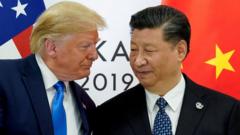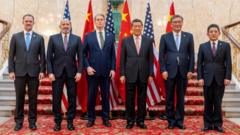During a state visit to Cambodia, President Xi Jinping's symbolic gestures and infrastructure investments highlight China's dominance in Southeast Asia, especially as U.S. influence wanes under President Trump's administration.
Xi Jinping's Diplomatic Charm Offensive in Cambodia

Xi Jinping's Diplomatic Charm Offensive in Cambodia
As China strengthens its relationship with Cambodia, President Xi Jinping's recent visit showcases the strategic ties between the two nations amid rising tensions with the U.S.
Article:
Xi Jinping Boulevard encircles Cambodia’s rapidly developing capital, Phnom Penh, where street signs in Chinese are increasingly dominating the landscape. This major thoroughfare, named in honor of China’s leader last year, is set to connect to a newly constructed airport, projected to be among the ten largest globally. As Xi arrived in Phnom Penh on Thursday, he was met with giant red banners and portraits of himself, as Cambodians, hired for $2.50, waved Chinese flags.
This trip occurs amid escalating tensions shaped by the United States' plans for a substantial 49 percent tariff on Cambodian exports, which include garments for major brands such as Nike and Lululemon, alongside the withdrawal of various aid initiatives. With a narrative rooted in providing investment and support, Xi’s Southeast Asia tour, which also touched upon visits to Vietnam and Malaysia, underscores a significant geopolitical shift — one in which China is asserting itself prominently over the region.
China has positioned itself as the predominant trading partner and foreign investor in Cambodia, mirroring its influence in numerous developing countries. Xi effectively portrays Beijing as a staunch ally in stark contrast to a United States seemingly retreating from its global leadership role under President Trump.
“This is classic geopolitical theater, and Xi’s timing is no accident,” commented Sophal Ear, a Cambodia-born political scientist at Arizona State University. “As the U.S. reduces its presence in Cambodia, China not only fills the vacuum but also presents itself as a steadfast and reliable partner.”
Xi Jinping Boulevard encircles Cambodia’s rapidly developing capital, Phnom Penh, where street signs in Chinese are increasingly dominating the landscape. This major thoroughfare, named in honor of China’s leader last year, is set to connect to a newly constructed airport, projected to be among the ten largest globally. As Xi arrived in Phnom Penh on Thursday, he was met with giant red banners and portraits of himself, as Cambodians, hired for $2.50, waved Chinese flags.
This trip occurs amid escalating tensions shaped by the United States' plans for a substantial 49 percent tariff on Cambodian exports, which include garments for major brands such as Nike and Lululemon, alongside the withdrawal of various aid initiatives. With a narrative rooted in providing investment and support, Xi’s Southeast Asia tour, which also touched upon visits to Vietnam and Malaysia, underscores a significant geopolitical shift — one in which China is asserting itself prominently over the region.
China has positioned itself as the predominant trading partner and foreign investor in Cambodia, mirroring its influence in numerous developing countries. Xi effectively portrays Beijing as a staunch ally in stark contrast to a United States seemingly retreating from its global leadership role under President Trump.
“This is classic geopolitical theater, and Xi’s timing is no accident,” commented Sophal Ear, a Cambodia-born political scientist at Arizona State University. “As the U.S. reduces its presence in Cambodia, China not only fills the vacuum but also presents itself as a steadfast and reliable partner.”






















